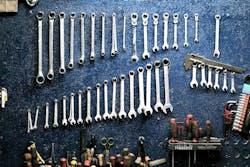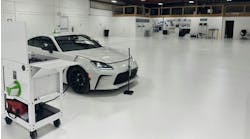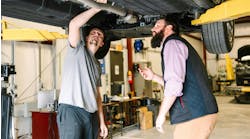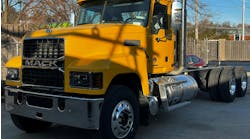SHOP STATS: Precision Collision Paint & Auto Body Location: Manchester, Iowa. Operator: Jeff Domeyer Average Monthly Car Count: about 18 Staff Size: 5 Shop Size: 5,500 sq ft; Annual Revenue;$1 million
Jeff Domeyer has consistently kept a clutter-free workspace without spending tons of money.
His shop uses 55-gallon totes for all R&I parts, and has a dedicated parts room with lines taped on the floor to indicate where carts go when full and empty. Domeyer made his own cabinet to hang on the wall and store the shop’s computer, tablets, phones and more. He even made a cart for all of the shop’s trim panels, door and quarter glasses.
By looking into other avenues of storage, Domeyer has saved thousands for his shop, Precision Collision Paint & Auto Body, in Manchester, Iowa.
His innovative mentality came when he first opened the business. For four to five months, Domeyer, the shop’s owner, handled every role at the facility. He was the bodyman. He was the estimator. He was the front office manager.
That experience has served the shop owner well as he has set out to solve issues in his shop. For example, when Domeyer noticed his estimator wasted significant time every day running around the shop and trying to find the necessary pieces of equipment, he began to wonder how he could reduce that time.
Domeyer’s relaxed, go-with-the-flow business strategy has allowed the shop to find a unique solution to a clutter-filled facility and increase efficiency, he says.
The Backstory
Before opening his shop in 2010, Jeff Domeyer worked in the collision repair industry as a combination body and paint technician. From the first time he entered the industry, he aimed to take control of his own career path, he says.
Domeyer opened his shop in a small town near where he was born and grew up. The shop is situated in a small market in eastern Iowa. Most of the repair work comes from a nearby town that has roughly 5,000 residents. In the whole county, there are only about 18,000 people.
Still, the shop has steadily grown since it first opened, with a slightly lower growth rate in the last few years, Domeyer says.
The Problem
Domeyer has found over time that the shop processes flow better when the estimator works as more of a “back-end estimator,” or blueprinter, instead of an estimator staying in the front office. Domeyer joined the board for the Iowa Collision Repair Association, joined the Tri-State Auto Body Association, Society for Collision Repair Specialists and Management Success to gain feedback from other collision repair experts. He said he was prompted to join because he realized a lot of people just sit back and complain without trying to learn a solution. He wanted a solution.
And, he soon discovered other shops used a type of blueprinting and disassembly cart.
In 2016, Domeyer realized if his estimator worked as more of a blueprinter, the estimator could use an area to focus on this work. His estimator was already pushing for a cart to use and displaying characteristics of tech savviness, thoroughness in the job and performing estimates per OE guidelines with very few exceptions, Domeryer says.
The estimator was spending time in a designated office in the front of the shop, writing estimates, handling walk-in customers and running between the office and shop floor to deal with supplements and parts problems.
While Domeyer looked around at the options, he noticed the carts on the market were all out of his budget.
And, in addition to being too expensive, the estimating carts were missing some key features he was seeking, including storage drawers and monitor options.
The Solution
Ultimately, Domeyer decided to build his own estimating cart. For roughly two months, he searched for options to use as the base of the cart. Once he found all the right pieces to build the cart, it only took him a day to put it together.
The total project cost about $1,500. Other models on the market can cost upward of $2,700 or $4,000 depending on the features. Domeyer bought the storage drawers and bottom half of the cart at a Lowe’s Home Improvement hardware store. Then, he purchased a laser printer and scanner from his local Best Buy. He found the printer and scanner on the advice of his estimator.
He built the cart to work with the shop’s estimating system, Microsoft Service Pro. The Microsoft Service Pro tablet can be plugged into the computer monitor on the cart and transferred to the screen. The cart then has to be plugged into a wall outlet, but it runs off the shop’s WiFi.
Since Domeyer’s estimator already used the Microsoft Service Pro technology, he says he wanted to incorporate it into the cart design.
“I wanted dual monitors, which, in my opinion, is a must, and a place to store common things needed during blueprinting, so drawers were a must, also,” the shop owner notes.
The dual monitors are adjustable as well, Domeyer says. In order to add comfort and flexibility for the person using the cart, he created adjustable monitors that can move up or down, tilt in any direction or even be flipped in a complete 360-degree fashion.
The Aftermath
The shop’s estimator took on a new title of repair planner and has been able to cut back on the amount of time spent running from the shop to the office and back, all because of the cart’s dual monitors.
Not only has Domeyer witnessed time savings from creating his own cart with dual monitors, he has also noticed a more thorough repair plan, he says. Now, the repair planner is able to eliminate large supplements because he works alongside the technicians as they disassemble vehicles.
There are still supplements, Domeyer acknowledges, but they’re more rare than before. For example, supplements can be parts price differences, and paints and materials differences.
Overall, the shop has reduced supplements because the estimator is able to work right next to the technician as he or she is disassembling a vehicle.
The Takeaway
Domeyer says he wondered why he did not take the leap to build a new estimating cart or a back-end estimator earlier in his career.
The simple addition of the dual monitors has saved the shop a couple hours per week in terms of going back and forth between programs, which would have to be done on single monitor. It is cheaper for Domeyer to make the shop’s organizational items himself, he says. He realized the greater reward was having a customized cart to fit every single one of his needs.
As a small shop that attempts to continuously invest heavily in training and equipment, Domeyer says the shop has been challenged but able to be successful through cost-effective projects.



